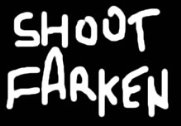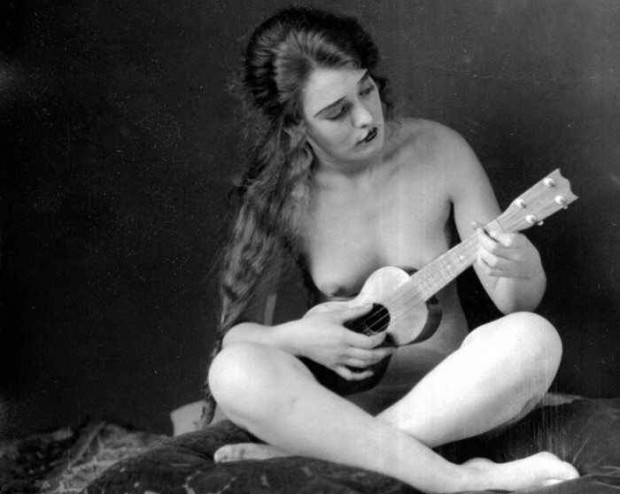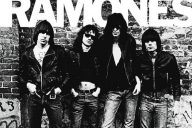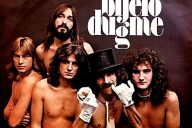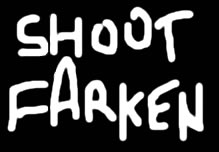He walked onto the set of a national TV show looking like a man who would be derelict were his mother to die.
Watching Tiny Tim perform his best-known song, “Tiptoe Through the Tulips”, on The Johnny Carson Show in 1968 is weird even now, some 46 years later. Forty-six years later. That’s almost half a century.
But then Tiny Tim is like a spirit that exists beyond time.
It visited this planet, picked up a ukulele, warbled in its otherworldly falsetto, and lived among us, all the while assuming human form — maybe like a member of the Great Race of Yith, a fantastic alien creation from the mind of horror writer HP Lovecraft — assuming a shape and identity in our spatial and temporal dimension but never really being of this world.
On November 30, 1996, Tiny Tim played a show at The Woman’s Club of Minneapolis. The club is a long-established and well-respected institution, as its website states: “A preferred venue for elegant social gatherings, the Club has also hosted speakers ranging from a Thomas Friedman lecture to a Garrison Keillor talk in our Theatre.”
The last song Tiny Tim played before his human form expired was “Tiptoe Through the Tulips”.
In a documentary that traces the final days of Tiny Tim’s life, playwright Max Sparber walks us through the last hours of the man born as Herbert Khaury, the son of a Polish Jewish mother and Lebanese Catholic father. Sparber recounts what happened at that last gig:
“Reportedly the band leader didn’t treat him very well. Didn’t want to perform with him; claimed he didn’t know any of the songs; and then didn’t introduce him, so when Tiny Tim went up to perform a lot of the people had actually left thinking the event was over.
“Tiny Tim performed his entire set, but he was off tune, his ukulele wasn’t tuned properly. He had cords wrapped around his legs and over the course of the performance he turned completely pale and started shaking.
“He finished off with ‘Tiptoe Through the Tulips’ and his wife got up to see if he was okay. She asked him if he was okay, he said, ‘No, I’m not’ and those were to be the last words Tiny Tim ever said.”
The Joy of Ukulele
Like Tiny Tim, Australian musician Vance Joy started life with another name, and he was doing quite well with that name.
As James Keogh, he had made his way through young adulthood with, on the surface of things, few problems. He had been a talented enough Aussie Rules footballer to play in the VFL (a second-tier feeder competition for the big league AFL), as well as a good enough scholar to have completed a law degree at the prestigious University of Melbourne. He had also been school captain at St Kevin’s College, one of Melbourne’s top private schools.
A St Kevin’s College newsletter from last year gives a brief hint to why James Keogh chose to become Vance Joy (the name of a character in the Peter Carey novel Bliss): “As Vance Joy, a name that allows him to put aside James Keogh’s history and the associated expectations of others, the 25-year-old has issued an impressive debut EP, established a live following and found favour with national youth broadcaster Triple J.”
Vance Joy did find considerable favour with Triple J and its audience, which voted his ukulele-driven song “Riptide” into number one place in its annual Hottest 100 countdown for 2013, above the song everyone had expected would take out the top prize, teenage pop sensation Lorde’s “Royals”.
“Riptide” is the type of highly accomplished piece of modern indie folk pop that invariably ends up in ads for young people’s health insurance.
Joy’s chart-topper is only one of the latest in a long line of pop songs from the past decade to use the ukulele’s distinctive strum as a key component. A short list of just some of these songs includes: “I’m Yours”, Jason Mraz; “Hey, Soul Sister”, Train; “You and I”, Ingrid Michaelson; “Five Years’ Time”, Noah and the Whale; and “The Lazy Song”, Bruno Mars.
Of course, then there is also Eddie Vedder’s ukulele album, Amanda Palmer’s ukulele/Radiohead covers album, plus songs by the likes of Magnetic Fields, Beirut, Taylor Swift and plenty more.
The rise and rise of the ukulele as a musical shorthand for whimsy and soulfulness is evident by its pervasiveness in contemporary pop music, especially in its quasi “indie” manifestations, as this article in The New York Times points out:
“Now it permeates the culture to an extent that it hasn’t in more than half a century, turning up in Top 10 pop songs and fashionable indie-rock bands, in television commercials by the hundred and YouTube videos by the thousand. There definitely is something going on here.”
“It symbolizes everything that the grand polished machine of the music industry is not,” said Amanda Palmer, a singer formerly with the punk-cabaret group Dresden Dolls.
“The Fearless Eyed” Angel Over the Rainbow
‘Brudda Iz’ was already famous in Hawaii when he released “Somewhere Over the Rainbow”, the song that was to bring him posthumous worldwide recognition.
Before his solo career, Israel “Iz” Kaʻanoʻi Kamakawiwoʻole — “Fearless Eyed” in Hawaiian — was a member of the Makaha Sons of Niʻihau, a group which was at the forefront of the “Hawaiian Renaissance” musical movement of the 1970s and ’80s.
It could be argued that — along with the rise of the “old, weird America” movement and the revival of burlesque musical forms — one of the main sources of inspiration for the ukulele pop movement of the past decade or so can be traced right back to Hawaii, the spiritual home of the instrument, and the massive success of Kamakawiwoʻole’s version of the Harold Arlen and EY Harburg song from The Wizard of Oz. (Of course, Tiny Tim had covered the song as well.)
Though geographically remote, Hawaii’s culture has exerted a subtle influence on the haole (white Americans) since the incorporation of the islands into the United States; first when it became a territory of the USA in 1898 and then when it became a fully-fledged state in 1959.
Musically, the influence is apparent through the use of the Hawaiian lap steel guitar in blues, and country and western; the ‘hula’ rhythms and motifs in lounge exotica; the iconography of surf rock; and more recently through the ‘Jawaiian‘ hybrid of Hawaiian and reggae music that became popular in the 1970s and 80s throughout the islands.
Brudda Iz released his version of “Somewhere Over the Rainbow” in 1993, recorded and produced by Jon de Mello, the creative force behind the Mountain Apple Company, the music label at the centre of so much of the Hawaiian Renaissance scene of the 70s and beyond. While the song was successful upon release in Hawaii, when Hollywood picked up on the song’s romantic lilting tones its longer lasting influence was felt on pop culture.
Throughout the late ’90s and 2000s the song was featured in a succession of films, TV shows and ad campaigns, including Meet Joe Black, Finding Forrester, 50 First Dates, ER and Scrubs. In the song’s official video, Kamakawiwoʻole’s massive frame (he weighed 348kg at one stage), naked from the top up, juxtaposed by his tiny ukulele, quickly became an image that haole identified with as the gentle soulfulness of an idyllic Hawaii. The video has been watched 100 million times on YouTube.
His death on June 26, 1997, from obesity related health issues, only accelerated his canonisation as one of the great figures of Hawaiian music and cultural life. The mythology behind Brudda Iz continues to grow, helped along by his famous song’s seemingly eternal life in film and TV land, and by the hagiographic words of de Mello:
“This native son was a rare breed, an almost pure Hawaiian of unusual lineage; he could trace his ancestral roots to an island that even today, remains the most Hawaiian of all, the so-called “forbidden” island of Ni’ihau.”
Jack Johnson and Bruno Mars are two Hawaiian pop musicians who have certainly copped parts of the Brudda Iz, as well as Jawaiian, DNA. And there’s probably trace elements in the likes of John Butler, Jason Mraz and Ben Harper too.
In a way, Israel “Iz” Kaʻanoʻi Kamakawiwoʻole reclaimed the ukulele as an instrument which could do more than be plucked badly by amateurs or played by old-timey music nerds intent on reliving the early 1900s. Once his version of “Somewhere Over the Rainbow” hit the mainstream, the ukulele was elevated above its station of novelty toy instrument, not by Jake Shimabukuro-style technical wizardry, but by its capacity to connect to its audience in a very heartfelt way.
The Buddha vibe of Brudda Iz is exemplified by a conversation he had with his producer, de Mello, recounted by de Mello in an interview with NPR:
“I was scared when I lost my mother, my father, my brother, my sister,” Israel told de Mello. “I guess this is gonna sound kind of weird, but I’m not scared for myself for dying. Because I believe all these places are temporary. This is just one shell. Because we Hawaiians live in both worlds. It’s in our veins. When our time come, don’t cry for me. Don’t cry for me. Plant a tree in the middle … where they play soccer,” he laughs. “Kind of small, then I’ll grow big.”
Tiny Tim and the Anti-Christ
While the sound of the ukulele has become an easy signifier of musical quirk, the four-stringed accompaniment to the cult of quirkinality, one of the most recent pop culture incarnations of “Tiptoe Through the Tulips” could be found on the soundtrack to creepy horror film Insidious, directed by James Wan, one of the Australian directors behind the Saw franchise.
Its use in the film taps into the weird, dark undercurrents that swirl beneath the surface of Tiny Tim’s nostalgia-tinged work. It’s an element of his music that was recognised by the likes of psychedelic-industrial artists Nurse With Wound and Current 93, who recorded an album in 1995 with the tulip tip-toer called Songs of an Impotent Troubadour.
On one of the album’s songs, “Anti-Christ”, Tiny Tim expounds on his views about religion and the coming demise of humanity (possibly exposing his Yith powers of precognition?):
“My opinion is that He will be from outer space. That He will be a demon, scary to the human eye, very, very fearful. I believe that He will be from another galaxy… Earth will be captured by unbelievable monsters and anti-Christs…this will happen in the next few centuries…
“To many who hear this tape, to many who listen to this, especially coming from Tiny Tim, eccentric weirdo star of the past, they’ll either not listen; take it as a joke; or say it’s sick. They can say whatever they want – maybe they’re right. I certainly don’t know if I have this great wisdom; I praise the Lord for it. If I don’t, I praise Him for letting me realise that.
“But in my opinion – and that’s why I stated those three words, IN MY OPINION only – I believe that the anti-Christ will be from another galaxy, another world.”
Herbert Khaury, with his funny voice (which had a far bigger range than most people know) and dinky little Hawaiian instrument, was always going to be an outsider, not of here. Even in the Age of Aquarius of the late 1960s, Khaury could never really buy in to the prevailing, hegemonic idea of non-conformity; he would remain the geek the other freaks gawked at. He had an encyclopaedic knowledge of old-time popular song (here’s the original version of “Tiptoe” from 1929), especially from the 1920s and ‘30s, and it was this archive of song that he brought forth into the popular culture of the 1960s — channeling the sounds of the dead departed in the age of the groovy.
He was, of course, not alone in this fascination with the sounds of a pre-rock culture and a lot of other pop artists of the time – Harper’s Bizarre, Van Dyke Parks, The Zombies, Herman’s Hermits, Harry Nilsson to name a few – were also dipping into the well of songs they might have still heard on radio or that had been passed down to them through parents and grandparents. But there was probably no one as hauntingly evocative of this almost-lost era as Tiny Tim.
Path of Joy
Like one of those clean-cut innocents who stumbles blind into a David Lynch film only to discover a world of backward talking midgets, psychotic small town crooks and moments of absurd beauty, James Keogh one day picked up a ukulele and strummed a sweet, sweet tune.
In the process, he adopted the persona of Vance Joy: “…a name that allows him to put aside James Keogh’s history and the associated expectations of others.” He has become a big hit too, signing a five album record deal with Atlantic Records.
It remains to be seen what path Joy takes, but as a strummer of the ukulele he walks down a musical highway rich in history, high in weirdness and deep in soul.
________________________
(WARNING: If you really want to chase a Lovecraft rabbit down a David Lynch wormhole then follow this trail down a dark road into an existential forest. Tiny Tim’s album from 1980 was called Chameleon and it featured his usual range of old-timey Tin Pan Alley tunes plus a stomping cover version of the Bee Gees’ “Stayin’ Alive”. The album cover depicts Tim in a rather Nosferatu/Dracula manner — a bit proto Goth. Now have a look at the cover of Chameleon next to the cover of Marilyn Manson’s 2012 album, Born Villain: like father, son and the malevolent spirit! Of course, among his many accomplishments Marilyn Manson (born Brian Hugh Warner) had a bit part, listed as a Porn Star #1 on IMDB, in David Lynch’s Lost Highway and also covered “I Put a Spell on You” for the soundtrack. One of the very best and most frightening characters to ever appear in a Lynch film was Lost Highway‘s Mystery Man, played by Robert Blake (born Michael James Vincenzo Gubitosi). Mystery Man also went for the white make-up, slicked back Lugosi-style Dracula hair-do favoured by Tim on the Chameleon album cover. In this incredibly creepy scene, he displays Yith powers of precognition and general time-space-identity fuck-shit-up-edness. As Bill Pullman’s character says to Mystery Man, “That’s fucking crazy, man.”)
